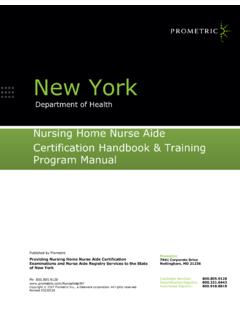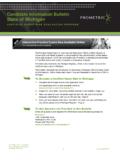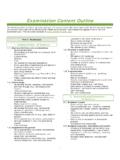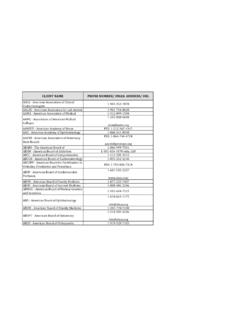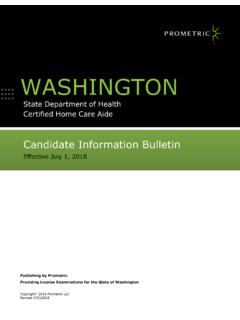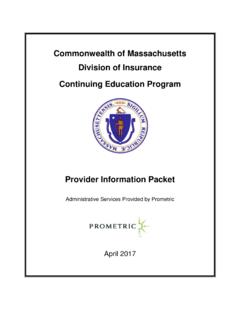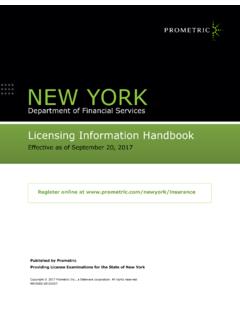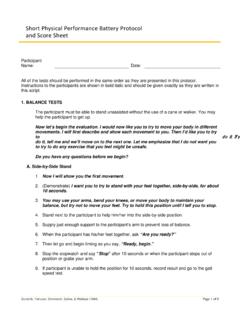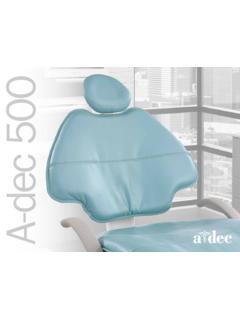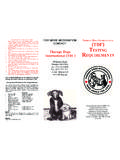Transcription of Clinical Skills Test Checklist - Prometric: Trusted Test ...
1 1 20140101 Copyright 2014 prometric Inc., a Delaware corporation. All Rights Reserved. Clinical Skills Test ChecklistDuring training, you learn many Skills that are important in caring for residents. There are 22 Skills that are part of the Clinical Skills Test. When you are registered to test, a computer will decide which Skills will be on your test. A Clinical Skills Test consists of five scored Skills . All candidates taking this test are scored on the Handwashing and Indirect Care Skills . When you take your test, you will be given instructions for the other three Skills that are part of your test. Because you learn to perform Skills in different ways for different residents needs, you are given instructions that describe how the skill is being tested.
2 For example, if you test on the feeding skill, you will feed a resident positioned in a chair. Remember, you are still responsible for knowing how to feed residents who are positioned in other ways. The Knowledge (Written) Test may also ask questions about feeding residents in other different positions. Each skill in the test has checkpoints. The nurse(s) giving your test will use these checkpoints to rate your performance. After you complete your test, the nurse will enter his/her observations into a computer. prometric s system will then determine your results. Your results are provided on the day of testing, unless a technology issues, such as a printer problem at the test site, prevents the nurse from providing your results.
3 If you are not provided a score report on the day of testing, see the candidate bulletin for information on accessing your results online. The checkpoints for each of the Skills are listed on the pages that follow. It is important that you understand that the checklists are not written as procedures. These checkpoints are not provided to help you learn Skills , but to help you understand what the nurse will look for when you perform a skill. The procedures for Skills are learned from your instructor, nurse aide textbooks, and other training materials. The procedure for any skill may include more detail about important requirements than are shown in the checkpoints.
4 Your performance may include more detail than is included in the checkpoints. A description of the instructions given to candidates for each skill is provided below before the checkpoints for each skill. This description includes if a person or mannequin is used for the resident. Usually another candidate will play the role of the resident when a person is used. In special situations, the nurse may need to play the resident. While you are waiting to take the test, you will be given General Instructions to read. These are the basic rules for the Clinical Skills Test. For example, these instructions explain what you need to do when you want to make a correction to a skill you are performing.
5 These General Instructions are also available on the Web site for your state at You are encouraged to review them before you arrive at the test site. When you are called into the testing room to take your test, you will be shown around the room so you can see where equipment and supplies are located. The testing room will be set up similar to a resident s room. For example, personal care supplies such as the resident s toothbrush, toothpaste, basins, and bedpan will be in the resident s bedside cabinet. When you are taking your Clinical Skills test, you are required to actually perform the Skills . This means you must really give care to the actor or mannequin. If the skill requires water to give care, you must really use Clinical Skills test is timed, and the amount of time is based on the combination of Skills on your test.
6 The nurse is not allowed to answer any questions about how Skills are performed at any time. Handwashing When taking the test, candidates are not given instructions about when to wash their hands. This is because nurse aides are expected to know that their hands should be washed before any physical contact with a resident. Candidates are evaluated on how well they wash their hands (technique) during the first skill. In Florida, where two nurses will be observing your performance throughout the test, one nurse will observe your handwashing at the beginning of the first skill, and the other nurse will observe your handwashing at the end of first skill. After the first skill is completed, for the remainder of the test, handwashing is evaluated as a part of Indirect Care with the checkpoint, Use Standard Precautions and Infection Control Measures when providing care.
7 Handwashing Does the candidate: 1 Begin handwashing by wetting hands and applying soap to hands? 2 Use friction to distribute soap and create lather cleansing front and back of hands, between fingers, around cuticles, under nails, and wrists? 3 Provide cleansing friction for a minimum of 20 seconds with hands lathered with soap? 4 Rinse hands and wrists removing soap? 5 Use clean paper towel(s) to dry hands and wrists, and dispose of used paper towel in trash? 6 End handwashing skill with clean hands avoiding recontamination of hands before procedure completed ( , having direct contact with faucet handles or sink surfaces once hands washed)? c l i n i c a l s k i l l s t e s t c h e c k l i s t 2 Indirect Care Indirect Care is a skill that is evaluated while you perform each skill.
8 This skill evaluates behaviors that are common to any resident care such as: infection control, safety, communication, and resident preferences, needs, comfort and rights. You are not given instructions to perform the Indirect Care skill. The nurse watches for these behaviors while you perform each skill. In the checkpoints provided for each skill below, Indirect Care checkpoints are identified with an (IC) at the end. Indirect Care is one of the five Skills scored in every Clinical Skills Test. The Indirect Care checkpoints are: Does the candidate: 1 Greet resident, address by name, and introduce self? (IC) 2 Provide explanations to resident about care before beginning and during care?
9 (IC) 3 Ask resident about preferences during care? (IC) 4 Use Standard Precautions and infection control measures when providing care? (IC) 5 Ask resident about comfort or needs during care or before care completed? (IC) 6 Promote resident s rights during care? (IC) 7 Promote resident s safety during care? (IC) Ambulate the resident using a transfer/gait belt The candidate is asked to walk a resident who needs some assistance to stand. A transfer/gait belt is used while walking the resident. The role of the resident is played by a person. Does the candidate: 1 Greet resident, address by name and introduce self? (IC) 2 Provide explanations to resident about care before beginning and during care?
10 (IC) 3 Apply transfer/gait belt before standing resident, placing around the resident s waist and over clothing, secure so that only flat fingers/hand fit under belt, and the belt does not catch skin or skin folds ( breast tissue)? 4 Provide signal or cue to resident before assisting to stand? 5 Assist resident to stand while holding onto the transfer/gait belt without holding belt only at the front or only at nearest side (if assisting to stand from the side)? 6 Ask about how resident feels upon standing? 7 Walk resident while standing to the side and slightly behind resident? 8 Provide support while walking resident with an arm around resident s back holding transfer/gait belt?
